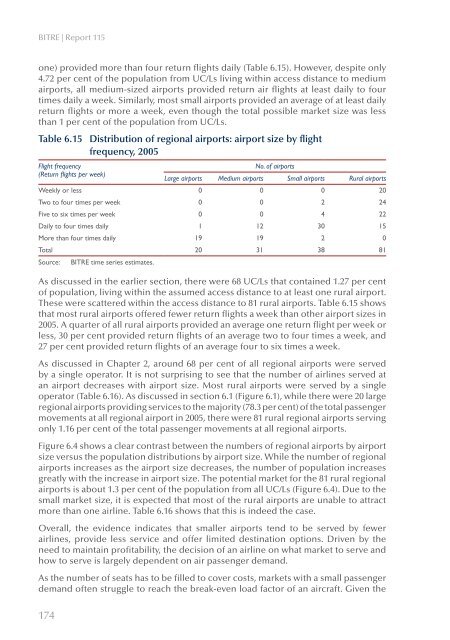PDF: 5191 KB - Bureau of Infrastructure, Transport and Regional ...
PDF: 5191 KB - Bureau of Infrastructure, Transport and Regional ...
PDF: 5191 KB - Bureau of Infrastructure, Transport and Regional ...
- No tags were found...
You also want an ePaper? Increase the reach of your titles
YUMPU automatically turns print PDFs into web optimized ePapers that Google loves.
BITRE | Report 115one) provided more than four return flights daily (Table 6.15). However, despite only4.72 per cent <strong>of</strong> the population from UC/Ls living within access distance to mediumairports, all medium-sized airports provided return air flights at least daily to fourtimes daily a week. Similarly, most small airports provided an average <strong>of</strong> at least dailyreturn flights or more a week, even though the total possible market size was lessthan 1 per cent <strong>of</strong> the population from UC/Ls.Table 6.15 Distribution <strong>of</strong> regional airports: airport size by flightfrequency, 2005Flight frequencyNo. <strong>of</strong> airports(Return flights per week)Large airports Medium airports Small airports Rural airportsWeekly or less 0 0 0 20Two to four times per week 0 0 2 24Five to six times per week 0 0 4 22Daily to four times daily 1 12 30 15More than four times daily 19 19 2 0Total 20 31 38 81Source: BITRE time series estimates.As discussed in the earlier section, there were 68 UC/Ls that contained 1.27 per cent<strong>of</strong> population, living within the assumed access distance to at least one rural airport.These were scattered within the access distance to 81 rural airports. Table 6.15 showsthat most rural airports <strong>of</strong>fered fewer return flights a week than other airport sizes in2005. A quarter <strong>of</strong> all rural airports provided an average one return flight per week orless, 30 per cent provided return flights <strong>of</strong> an average two to four times a week, <strong>and</strong>27 per cent provided return flights <strong>of</strong> an average four to six times a week.As discussed in Chapter 2, around 68 per cent <strong>of</strong> all regional airports were servedby a single operator. It is not surprising to see that the number <strong>of</strong> airlines served atan airport decreases with airport size. Most rural airports were served by a singleoperator (Table 6.16). As discussed in section 6.1 (Figure 6.1), while there were 20 largeregional airports providing services to the majority (78.3 per cent) <strong>of</strong> the total passengermovements at all regional airport in 2005, there were 81 rural regional airports servingonly 1.16 per cent <strong>of</strong> the total passenger movements at all regional airports.Figure 6.4 shows a clear contrast between the numbers <strong>of</strong> regional airports by airportsize versus the population distributions by airport size. While the number <strong>of</strong> regionalairports increases as the airport size decreases, the number <strong>of</strong> population increasesgreatly with the increase in airport size. The potential market for the 81 rural regionalairports is about 1.3 per cent <strong>of</strong> the population from all UC/Ls (Figure 6.4). Due to thesmall market size, it is expected that most <strong>of</strong> the rural airports are unable to attractmore than one airline. Table 6.16 shows that this is indeed the case.Overall, the evidence indicates that smaller airports tend to be served by fewerairlines, provide less service <strong>and</strong> <strong>of</strong>fer limited destination options. Driven by theneed to maintain pr<strong>of</strong>itability, the decision <strong>of</strong> an airline on what market to serve <strong>and</strong>how to serve is largely dependent on air passenger dem<strong>and</strong>.As the number <strong>of</strong> seats has to be filled to cover costs, markets with a small passengerdem<strong>and</strong> <strong>of</strong>ten struggle to reach the break-even load factor <strong>of</strong> an aircraft. Given the174
















